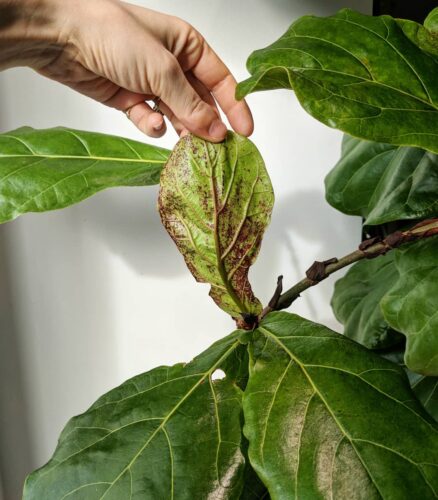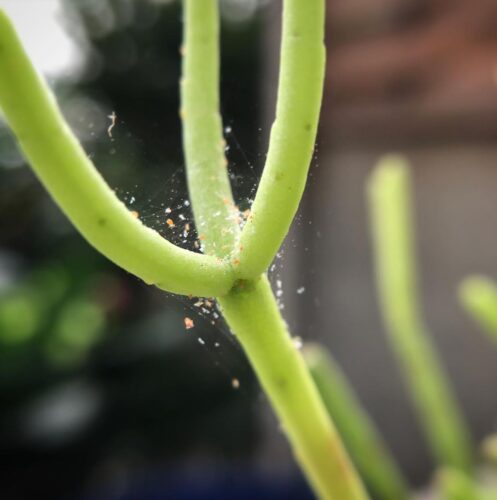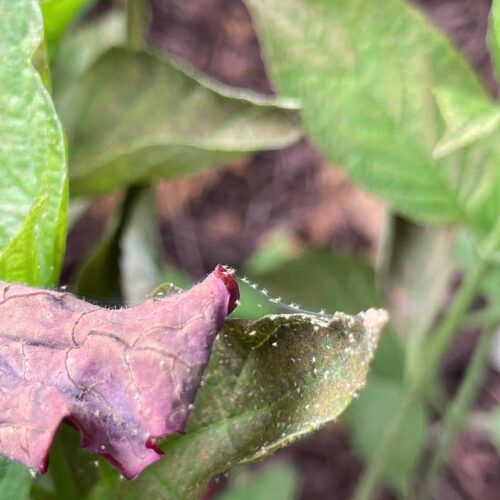Read about the First Signs of Spider Mites on Plants and How to Prevent Them with the help of this comprehensive guide.
Learn about the Signs of Spider Mites on plants and how you can prevent them and safeguard your plants from severe infestation in this detailed post.
Read: What Do Leaf Bugs Eat?
First Signs of Spider Mites

1. Webbing on the Plants
This is the most obvious sign of spider mite infestation: when you see fine, silky webbing between or on the underside of the foliage, it confirms this pest attacks your plant. These webs provide protection to the mites from predators and environmental factors.
2. Brown or Red Spots on the Foliage
Spider mites generate small brown, red, or yellow spots on the foliage. These spots appear when mites feed on the plant cells.
3. Clear Eggs and Mites
You can see the small spider mites and their red, yellow, brown, or green eggs on the undersides of the foliage using a magnifying glass.
4. Leaves Look Dusty
A spider mite infestation results in a dusty layer on the foliage.
5. Shriveled Foliage
Spider mite infestation causes leaf curling, wilting, or distortion. This condition occurs due to the feeding action of mites.
Read: What Attracts Ladybugs?
Preventing Spider Mites

Once it is confirmed that your plant is affected by spider mites, follow the below immediate steps to prevent infestation.
- Quarantine the Affected Plants: Prevent the spread of mite infestation to other plants in your collection by isolating the infected plant immediately.
- Prune the Affected Parts: Prune the infected parts of the plant and dispose of them carefully.
- Raise Humidity: Remember that spider mites flourish in dry environments. You have to create humid surroundings to repel mites. Also, mist the plant, use a pebble tray filled with water, or use a humidifier.
Read: Companion Plants for Pest Control
Eliminating Spider Mites

Spider mites spread from eggs you purchase from a nursery or surrounding plants in your home. In the initial egg phase, they survive winter and flourish during warm weather. They like dry and hot environments and turn active during spring and summer. Their life-cycle stay continues in hot climates all year round. To repel them, try the following tricks;
- Try Organic Miticides: You can use insecticidal soaps, horticultural oils, or neem oil. Use them according to the instructions on the label.
- Go with Home Remedies: Make a solution of mild dish soap, blend it with water, fill in a spray bottle, and target the undersides or leaves.
- Take Help of Natural Predators: Introduce lacewing larvae, ladybugs, or predatory mites; they will feed on spider mites.
Read: Do Marigold Deter Pests?
Points to Consider
- In dry and hot conditions, frequently examine your plants for the first sign of spider mites.
- Do remember healthy plants are less vulnerable to pest infection, and maintain the health of your plants with proper care that includes timely watering, feeding, and pruning.
- Avoid keeping the plants in areas with dry air, as spider mites prosper in these conditions.
- Keep your gardening tools clean, as it will help in the spread of spider mites to your plants.



